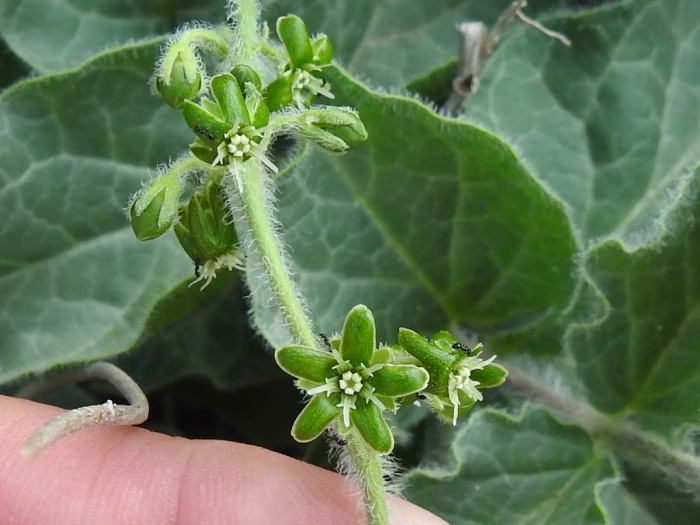Smallflower Milkvine
(Matelea parviflora)
Smallflower Milkvine (Matelea parviflora)
/
/

Sam Kieschnick
CC BY 4.0
Image By:
Sam Kieschnick
Recorded By:
Copyright:
CC BY 4.0
Copyright Notice:
Photo by: Sam Kieschnick | License Type: CC BY 4.0 | License URL: http://creativecommons.org/licenses/by/4.0/ | Rights Holder: Sam Kieschnick | Publisher: iNaturalist | Date Created: 2021-05-09T18:24:24-07:00 |





























Estimated Native Range
Climate Requirements for Middletown, New York
| This Plant | Your Site | Plant Suitability for Your Location | ||
|---|---|---|---|---|
| • Precipitation | 5" - 30" | 47" | Aquatic | Aquatic |
| • High Temp. | 86°F - 105°F | 84°F | OK, but your summers are milder than normal for this plant | OK |
| • Low Temp. | 28°F - 47°F | 16°F | Your winter temperatures may be too cold for this plant | Too cold |
This plant may not grow well at your location - your precipitation is too high.
Summary
Matelea parviflora, commonly known as Smallflower Milkvine, is a deciduous perennial vine native to Mexico, Arizona, and Texas, where it is found in a variety of habitats including thorn scrub, woodlands, prairies, and along streams in riparian zones. It typically grows to a height of 3-5 feet (0.9-1.5 meters) and can spread 1-5 feet (0.3-1.5 meters) wide. The vine is characterized by its twining habit and small, star-shaped greenish-white flowers that bloom in late spring to early summer. The flowers, while not particularly showy, are followed by interesting seed pods that add ornamental value in the fall.
Smallflower Milkvine is valued for its ability to attract butterflies, including the Monarch, which uses it as a host plant for its larvae. It is used in native plant gardens, butterfly gardens, and as a naturalizing element in informal settings. This vine is drought-tolerant, making it suitable for xeriscaping and gardens with low water availability. It thrives in full sun to part shade and prefers well-drained soils but is adaptable to various soil types. While generally pest-free, it can occasionally suffer from foliar diseases in overly moist conditions.CC BY-SA 4.0
Smallflower Milkvine is valued for its ability to attract butterflies, including the Monarch, which uses it as a host plant for its larvae. It is used in native plant gardens, butterfly gardens, and as a naturalizing element in informal settings. This vine is drought-tolerant, making it suitable for xeriscaping and gardens with low water availability. It thrives in full sun to part shade and prefers well-drained soils but is adaptable to various soil types. While generally pest-free, it can occasionally suffer from foliar diseases in overly moist conditions.CC BY-SA 4.0
Plant Description
- Plant Type: Herb
- Height: 3-5 feet
- Width: 1-5 feet
- Growth Rate: Moderate
- Flower Color: N/A
- Flowering Season: Spring, Summer
- Leaf Retention: Deciduous
Growth Requirements
- Sun: Full Sun, Part Shade
- Water: Medium, High
- Drainage: Medium
Common Uses
Butterfly Garden, Low Maintenance, Potted Plant
Natural Habitat
native to Mexico, Arizona, and Texas, where it is found in a variety of habitats including thorn scrub, woodlands, prairies, and along streams in riparian zones
Other Names
Common Names:
Scientific Names: Matelea parviflora, Lachnostoma parviflorum, Vincetoxicum parviflorum, Gonolobus parviflorus
GBIF Accepted Name: Matelea parviflora (A.Gray) Woodson